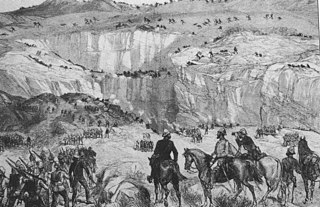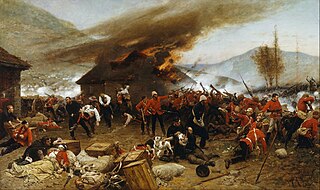 W
WThe 12 January 1879 action at Sihayo's Kraal was an early skirmish in the Anglo-Zulu War. The day after his invasion of Zululand, the British General Lord Chelmsford led a reconnaissance in force to the kraal of Zulu Chief Sihayo. This force had orders to burn the kraal to the ground as punishment for two of Sihayo's sons having entered the British Colony of Natal to kill two of Sihayo's wives who had fled there.
 W
WThe Siege of Eshowe took place during the Anglo-Zulu War of 1879. The siege was part of a three-pronged attack on the Zulu Impis of king Cetshwayo at Ulundi. After an incursion as far as Eshowe Colonel Charles Pearson was besieged there for two months by the Zulus.
 W
WThe Battle of Hlobane took place at Hlobane, near the modern town of Vryheid in KwaZulu-Natal, South Africa during the Anglo-Zulu War.
 W
WThe Battle of Intombe was an action fought on 12 March 1879, between Zulu troops and British soldiers defending a supply convoy.
 W
WThe Battle of Isandlwana on 22 January 1879 was the first major encounter in the Anglo-Zulu War between the British Empire and the Zulu Kingdom. Eleven days after the British commenced their invasion of Zululand in South Africa, a Zulu force of some 20,000 warriors attacked a portion of the British main column consisting of about 1,800 British, colonial and native troops and perhaps 400 civilians. The Zulus were equipped mainly with the traditional assegai iron spears and cow-hide shields, but also had a number of muskets and old rifles.
 W
WThe Battle of Kambula took place on 29 March 1879, during the Anglo-Zulu War, when a Zulu Army attacked the British camp at Kambula, having routed the mounted element of the British force at the Battle of Hlobane the day before. The battle was a decisive defeat and the Zulu lost their belief in victory. The war ended after the Battle of Ulundi on 4 July 1879.
 W
WThe Battle of Rorke's Drift, also known as the Defence of Rorke's Drift, was an engagement in the Anglo-Zulu War. The successful British defence of the mission station of Rorke's Drift, under the command of Lieutenants John Chard of the Royal Engineers and Gonville Bromhead, began when a large contingent of Zulu warriors broke off from their main force during the final hour of the British defeat at the day-long Battle of Isandlwana on 22 January 1879, diverting 6 miles (9.7 km) to attack Rorke's Drift later that day and continuing into the following day.
 W
WThe Battle of Ulundi took place at the Zulu capital of Ulundi on 4 July 1879 and was the last major battle of the Anglo-Zulu War. The British army broke the military power of the Zulu nation by defeating the main Zulu army and immediately afterwards capturing and razing the capital of Zululand, the royal kraal of Ulundi.